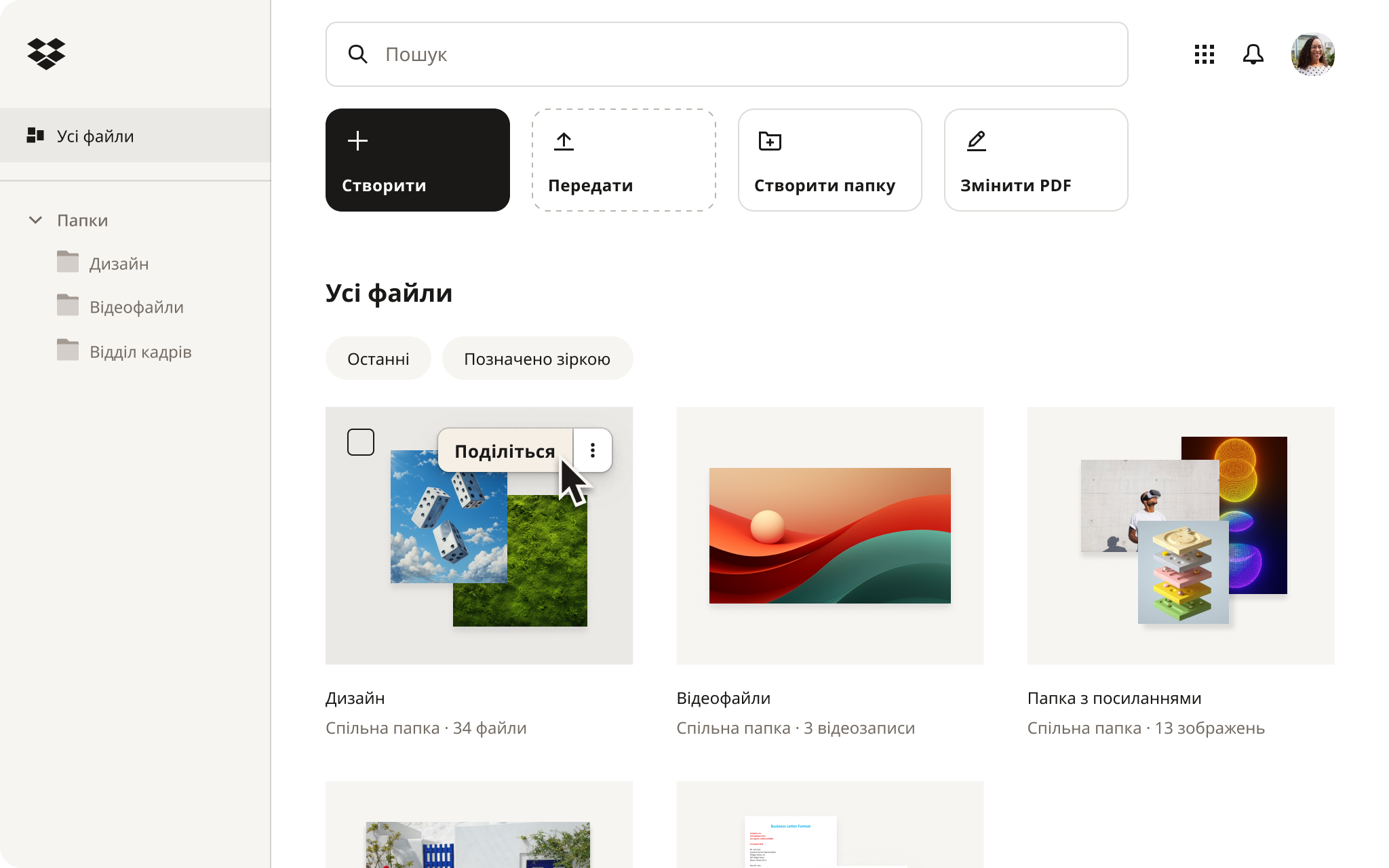Важко залучити внутрішніх або зовнішніх зацікавлених сторін? Дізнайтеся про практичні способи покращення співпраці зацікавлених сторін та досягнення кращих результатів проекту в цьому вичерпному посібнику.
У сучасному взаємопов’язаному бізнес-світі співпраця із зацікавленими сторонами важлива для досягнення успіху. Незалежно від того, чи йдеться про співпрацю з внутрішніми командами, зовнішніми партнерами чи зацікавленими сторонами, ефективна командна робота сприяє прийняттю кращих рішень, поліпшенню результатів і вищій продуктивності.
У цьому посібнику ми розглянемо 10 практичних способів покращення співпраці із зацікавленими сторонами та досягнення кращих результатів. Ми також покажемо вам, як Dropbox може оптимізувати процес і зробити роботу із зацікавленими сторонами більш продуктивною та ефективною.
Які типи зацікавлених сторін існують?
Зацікавлену сторону можна в широкому сенсі визначити як будь-кого, хто має особисту зацікавленість у вашому проєкті чи роботі або на кого вони впливають. Існує дві основні групи зацікавлених сторін:
- Внутрішні зацікавлені сторони— співробітники, керівники, члени команди проекту та інші особи у вашій організації, які безпосередньо залучені до проекту
- Зовнішні зацікавлені сторони —клієнти, постачальники, інвестори, регуляторні органи та інші особи чи організації поза вашою організацією, на яких впливає проект або які зацікавлені в ньому
Незалежно від типу зацікавленої сторони, ефективна співпраця є ключем до досягнення успішних спільних цілей та результатів проекту.
Інструменти для співпраці Dropbox, такі як Paper, Replay та Sign, спрощують обмін інформацією з різними зацікавленими сторонами та сприяють розвитку цих важливих партнерських відносин.

10 методів ефективної співпраці із зацікавленими сторонами
Визначити, хто відповідає за співпрацю із зацікавленими сторонами
Чітко визначте ролі та обов'язки тих, хто керуватиме взаємодією із зацікавленими сторонами. Призначте особу або команду основним контактним особою для зацікавлених сторін, забезпечуючи оптимізацію та ефективність комунікації. Розглянемо:
- Ролі— це можуть бути керівники проектів, фахівці з комунікацій або керівники команд
- Обов'язки— такі як підготовка та проведення презентацій для зацікавлених сторін, збір відгуків та оновлення графіків або дорожніх карт проектів
- Критерії відбору— такі фактори, як досвід, комунікативні навички та знайомство із зацікавленими сторонами, можуть визначити, чи підходить людина або команда для цього проєкту.
Дізнайтеся, хто є ключовими зацікавленими сторонами
Визначте ключових осіб, які приймають рішення та мають значний вплив на проєкт, та відповідно розставте пріоритети їхньої участі. Ці люди можуть відігравати ключову роль у формуванні цілей проекту, забезпеченні необхідних ресурсів та сприянні співпраці.
Кожна зацікавлена сторона матиме власні мотиви, які можуть впливати на її участь у проекті, такі як цілі відділу або цілі організації. Враховуйте їхні ролі, інтереси та рівень впливу, визначаючи, кого слід залучити до процесу співпраці. Наприклад, спонсор або партнер проекту може мати можливість виділити бюджет, тоді як технічний керівник може допомогти з доцільністю та впровадженням.

Визначте, як спілкуватися
Для ефективної роботи управління зацікавленими сторонами необхідні чіткі та ефективні канали комунікації. Особливо в нових проектах комунікація є надзвичайно важливою — вона допомагає вам керувати очікуваннями, працювати над досягненням спільних цілей та ознайомитися з потребами зацікавлених сторін.
Використовуйте гнучкі функції для комунікації від Dropbox, такі як спільні папки й спільна робота з документами в режимі реального часу, для забезпечення безперебійної взаємодії. Розгляньте можливість надання детальних регулярних оновлень або надсилання персоналізованих повідомлень, щоб підтримувати поінформованість і залученість зацікавлених сторін.
Визначте очікування та цілі
З самого початку встановіть чіткі цілі, терміни та кінцеві результати проекту. Це служить для об'єднання всіх зацікавлених сторін — членів команди, клієнтів та будь-яких інших залучених сторін — навколо спільного бачення та набору цілей.
Почніть із визначення чіткого напрямку, використовуючи такий метод, як цілі SMART, щоб сформулювати, чого прагне досягти проєкт. Наприклад, замість розпливчастої мети на кшталт «покращення задоволеності клієнтів», установіть більш конкретну й вимірювану мету, як-от «збільшити показники задоволеності клієнтів на 20 % за шість місяців».
Тримайте всіх в курсі того, хто за що відповідає та що від них очікується протягом усього проєкту. Це включає очікувані результати на кожному етапі проекту та план того, як оновлення будуть надаватися зацікавленим сторонам.

Прискорене затвердження проектів та збір відгуків
Повільні схвалення можуть перешкоджати співпраці та прогресу. Коли процес затвердження є повільним, це може призвести до вузьких місць, які затримують терміни проекту, дратують членів команди та зрештою впливають на якість кінцевого результату.
Цифрові інструменти, розроблені спеціально для керування документами та їх схвалення, є ефективним рішенням для цього. Наприклад, Dropbox Sign — це потужний інструмент, який дає змогу користувачам швидко й безпечно надсилати документи для електронного підпису. Завдяки Sign команди можуть усунути потребу у фізичній документації, скоротити час, витрачений на збирання підписів, і забезпечити своєчасне отримання схвалень зацікавлених сторін.
Окрім схвалення документів, творчі проєкти часто вимагають динамічнішого підходу до процесу зворотного зв’язку та внесення змін. У таких ситуаціях Dropbox Replay може відіграти вирішальну роль. Цей інструмент спеціально розроблений для відео й креативного контенту, даючи командам змогу ділитися своєю роботою та збирати або надавати відгуки у спрощений спосіб.
Завдяки функції «Повтор» співавтори можуть залишати коментарі з мітками часу безпосередньо до відео, що полегшує визначення конкретних моментів, які потребують уваги або перегляду. Це не лише пришвидшує процес перевірки, але й гарантує, що зворотний зв'язок буде чітким та практичним, що зменшує ймовірність непорозумінь та необхідність кількох раундів перегляду.
Розвивайте позитивну комунікацію та підтримуйте прозорість
Зосередьтеся на відкритому спілкуванні, активному слуханні та взаємній повазі під час взаємодії із зацікавленими сторонами. Ці принципи є важливими для побудови взаєморозуміння та сприяння довгостроковій співпраці.
Зміцнюйте довіру та сприяйте прозорій комунікації, заохочуючи відкритий діалог і конструктивну критику. Це передбачає надання зворотного зв'язку, який є не лише чесним, але й спрямований на допомогу окремим особам та проектам у вдосконаленні. Заохочення членів команди до конструктивної критики та її отримання може сприяти особистісному та професійному зростанню, оскільки дозволяє людям вчитися на своїх помилках та розвивати свої сильні сторони.
Також важливо інформувати зацікавлені сторони про хід виконання проекту. Регулярні оновлення щодо етапів проекту, досягнень та будь-яких виниклих труднощів допомагають забезпечити прозорість та підзвітність. Зацікавлені сторони повинні бути поінформовані про будь-які ризики, які можуть вплинути на проєкт, а також про стратегії, що використовуються для їх пом'якшення.
Крім того, процеси прийняття рішень повинні бути чітко доведені до відома зацікавлених сторін. Коли приймаються рішення, важливо пояснити їх обґрунтування, включаючи дані та висновки, які вплинули на цей вибір. Така прозорість допомагає зацікавленим сторонам зрозуміти контекст та міркування, що може призвести до більшої схвалення та підтримки проекту.
Отримайте інформацію від зацікавлених сторін
Використовуйте наявний досвід ваших зацікавлених сторін, заохочуючи їх ділитися своїми думками та досвідом. Це може призвести до кращого вирішення проблем та прийняття більш обґрунтованих рішень.
Ваші зацікавлені сторони володіють багатством безцінних знань, які можуть допомогти вам вирішувати проблеми та виявляти можливості. Різноманітний досвід та погляди зацікавлених сторін можуть розкрити нові ідеї, які можуть бути не одразу очевидними для вас чи інших членів вашої команди.
Наприклад, співробітники, які працюють з клієнтами, можуть запропонувати інформацію з перших вуст про потреби та вподобання клієнтів, тоді як партнери можуть запропонувати галузеві тенденції та передовий досвід, які можуть допомогти у прийнятті стратегічних рішень.
Шукайте проблеми та пропонуйте рішення
Проактивно виявляти потенційні проблеми або заперечення серед зацікавлених сторін та оперативно їх вирішувати. Передбачте їхні потреби та зменшіть ризики, щоб забезпечити безперебійну співпрацю.
Активно залучайте зацікавлених сторін, щоб зрозуміти їхні точки зору, занепокоєння та очікування. Регулярно проводите перевірки, опитування або сесії зворотного зв'язку, щоб отримати уявлення про думки та почуття зацікавлених сторін щодо проекту чи ініціативи.

Святкуйте спільні перемоги
Визнавайте й відзначайте досягнення разом із зацікавленими сторонами, щоб підвищити моральний дух і сприяти командній роботі. Це визнання може набувати різних форм, від простих усних подяк під час зустрічей до більш формальних відзначень, таких як церемонії нагородження або командні виїзди.
Почніть з визначення конкретного внеску окремих осіб та команд протягом усього проєкту. Це може включати визнання члена команди, який зробив усе можливе, щоб дотриматися стислого терміну, або групи, яка ефективно співпрацювала для вирішення складної проблеми. Це подає позитивний приклад для інших, заохочуючи культуру досконалості та співпраці.
Так само важливо відзначати віхи, досягнуті під час проекту. Віхи слугують значними показниками прогресу та досягнень, а їх визнання може посилити колективні зусилля команди з відповідними зацікавленими сторонами.
Наприклад, якщо ваш проект досяг критичної фази, такої як завершення важливого завдання або успішний запуск продукту, скористайтеся можливістю відсвяткувати цей успіх. Це може включати в себе проведення командного обіду, надсилання вітального електронного листа або навіть організацію невеликої зустрічі, щоб обміркувати пройдений шлях та поділитися історіями про подолані труднощі.
Використовуйте Dropbox для співпраці із зацікавленими сторонами — для кращих результатів
Ефективна співпраця із зацікавленими сторонами важлива для успіху проєкту, а Dropbox —це найкращий інструмент для забезпечення безперебійної командної роботи між кількома зацікавленими сторонами. Завдяки безпечному обміну даними, функціям співпраці й інструментам для творчого перегляду проєктів Dropbox дає змогу командам працювати разом злагоджено й досягати кращих результатів.
Найчастіші запитання щодо ефективної співпраці
Залучайте зацікавлені сторони до процесу прийняття рішень, активно запитуючи їхню думку та враховуючи їхні точки зору. Заохочуйте відкриті дискусії та надавайте їм можливості висловити свої ідеї та занепокоєння.
Використовуйте такі інструменти, як Dropbox, який пропонує низку функцій для віддаленої співпраці, включаючи спільні папки та редагування документів у режимі реального часу. Ці інструменти забезпечують безперебійне спілкування та співпрацю, незалежно від фізичної відстані.
Виявляйте та вирішуйте конфлікти на ранній стадії, сприяючи відкритим обговоренням та шукаючи спільну мову. Розставте пріоритети між найважливішими цілями та завданнями, а також працюйте над пошуком рішень, які задовольняють інтереси всіх зацікавлених сторін.


